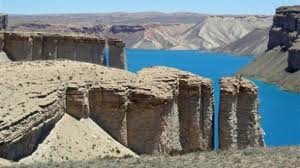
Bamiyan, Oct 23 – If the high mountain lakes of Band-e Amir were not in a country in its fourth decade of war they would be world famous.
Outsiders lucky enough to see them today are often lost for words when they first set eyes on the ethereal blue of their waters and the Martian-orange and red cliffs surrounding them.
The lakes, in Bamiyan province, are Afghanistan’s first-ever national park, and draw thousands of local visitors every year. The government hopes foreign tourists will one day come too.
If that sounds quixotic now, so too may the UN and the government’s launch here of the country’s first-ever environmental protection plan – with a solar-powered kettle one of its signature initiatives.
But for those living in Bamiyan’s isolated mountain valleys, the most immediate threat is not the Taliban but drought, partly induced by human activity.
Climate change is making things worse and the lakes could be at risk too.
Glaciers in the province’s Koh-e Baba mountains, the western end of the Hindu Kush, recede further each year.
The climate adaptation programme, as it’s known, “is not luxury, it’s life”, says Bamiyan Governor Habiba Sarabi after climbing up to Qazan, one of 18 mountain farming communities involved in the $6m (£3.75m) scheme. The high mountain lakes of Band-e Amir draw thousands of local visitors every year
‘Disaster-prone’
Some 3,000m (9,800ft) above sea level, this is always going to be a tough place to live and farm.
But it’s got tougher as trees and vegetation have been cut down for fuel – creating the beginnings of a high-altitude dust bowl.
In an Afghan version of the Grapes of Wrath, more families are being forced to leave every year.
Like shaved heads, most of the hillsides are bare, with just the occasional stubble of green.
It also means villages are more exposed to “flash-flooding in spring and summer and avalanches in winter”, says Andrew Scanlon of the UN Environment Programme.
But he is now overseeing the planting of new trees and turf along Qazan’s valley.
Against the repetitive clanging of hammer on metal, workers in Bamiyan city are building scores of cleaner, more-efficient stoves.
The solar kettle is just one of the initiatives to help Bamiyan adapting to climate change
Run by an Afghan NGO called the Conservation Organisation for the Afghan Mountains (COAM), the workshop sells them on preferential terms to local villages and it already has more orders than it can fulfil.
Mr Scanlon wants to expand the scheme elsewhere.
COAM is promoting another energy-saving device, the solar kettle.
It is basically a large satellite dish which reflects sun-rays onto a kettle suspended in the middle.
The bigger the dish the quicker the boil – but the one they are selling for about $100 can make a cup of tea in 20 minutes.
Yet with Nato forces retreating over the next two years, taking large chunks of aid money with them, there are concerns whether this tentative momentum can be maintained.
The New Zealand run civilian-military provincial reconstruction team (PRT) in Bamiyan is due to close early next year.
Catching up
There are questions, too, over the future of Bamiyan’s best-known landmark – the remains of the larger of its two rock Buddhas, blown up by the Taliban months before the US-led invasion in 2001.
The vast cave, or niche, carved into the mountainside 1,500 years ago looms over Bamiyan like a ghostly sentinel – and a permanent reminder of what happened.
But the niche is in “imminent danger of collapse”, says Brendan Cassar of Unesco – the UN’s cultural agency – and they need funding to shore it up.
Security concerns are pressing in too – from districts around Bamiyan where the Taliban and other armed groups have become more active.
That has had a knock-on effect on the small indigenous tourist trade here.
If foreign tourists are still a fledgling species here, Band-e Amir national park usually attracts a steady flow of Afghan visitors.
But there’s been a sharp fall in numbers this year, as the threat along the road towards Bamiyan has risen.
The park itself is still a long way from being managed like protected reserves elsewhere in the world. A guard with a piece of rope across the road is the gate-post.
There is little control on villagers who live next to the lakes. They have often used grenades and other explosives for fishing. Rubbish sometimes gets dumped in the waters.
But it is important to keep locals involved, “so they benefit”, says Mostapha Zaher, the energetic head of Afghanistan’s environmental protection agency – and grandson of the former king.
He admits he’s been called “unrealistic” for his dreams of developing national parks while the country is still in conflict.
But Mr Zaher insists it will happen, with plans underway for a second park in the Wakhan corridor – the finger of mountainous territory that takes Afghanistan all the way to China.
The UN deputy envoy Michael Keating, who has championed the environmental programmes, echoes his optimism: “Twenty years ago who would have thought Cambodia could become a tourist destination?”
To Afghans, the lakes are sacred waters and they believe have healing properties.
Perhaps one day, they will help heal Afghanistan too.

